Stay in the Loop
BSR publishes on a weekly schedule, with an email newsletter every Wednesday and Thursday morning. There’s no paywall, and subscribing is always free.
I don't read a great deal of detective fiction, but that changed not long ago when I read Janet Maslin's New York Times review of Kate Atkinson's Left Early, Took My Dog. Maslin's review characterized Atkinson's private eye Jackson Brodie as someone carrying on within "a game where you didn't know the rules or the identity of the players and where you were unsure of the goal"— in short, someone wrestling with an existential mystery that interests me more and more as I've aged.
I have now completed Atkinson's first three Brodie mysteries and am midway through Atkinson's debut novel, Behind the Scenes at the Museum, which won the Whitbread Prize as the best book of 1995. All reflect the feisty independence of a woman who marches very much to her own drummer.
Atkinson wrote three "literary" novels, a play and a short story collection before she turned to crime. Today, at the age of 60, twice divorced with two adult daughters and an unspecified number of grandchildren, she lives alone in Edinburgh. ("I've done lovers, husbands and children," she told one interviewer. "…There's a lot of messy stuff that's out of the way now.") She began writing fiction after her Ph.D. thesis on the American short story was rejected due to what she describes as "academic politics." When, decades later, the university offered her an honorary degree, she declined, saying she'd prefer her real one.
Multiple plot lines
Besides being independent and feisty, Atkinson is a wonderful writer whose works grip and entertain and provoke thought. She commonly sets in motion multiple plot lines, involving characters so distinctly feathered, fluttering along such seemingly unmatched patterns of flight, that it appears impossible that their flocks will ever meet. How they do is part of her charm.
Her narratives also mix buckets of gore with torrents of wit. At one point, she may detail the slaughter of a young mother, her small children and their dog by a knife-wielding maniac. At another, a daughter may describe her father as "so confrontational that he would swear black was white for the sake of an argument" while her mother "would go further, claiming it wasn't at all but a piece of furniture or a banana."
Atkinson is equally comfortable skewering modern-day entrepreneurs who "wore blindingly white shirts and handmade shoes" or family pieties (a mother reflects upon her grandchild, "To be honest, Gloria would have been more excited if her daughter had given birth to a puppy rather than the permanently angry Xanthia") or even God, whom one Atkinson character imagines as "a vague entity that hung around behind her left shoulder rather like a nagging parrot."
Bonds of grief, or skiing?
These judgments are usually rooted in solid philosophical musings about death or time or other milestones that "cast a long shadow on the soul." In Atkinson's world, "the shared twist of grief"— frequently the brutal deaths of parents or siblings or children— creates more of a bond than "a mutual love of skiing or Thai food or all the other things couples based their lives on."
But what I most enjoy about Atkinson is her bending of expectations and breakings of convention. Her characters change their names without public announcement. By some authorial sleight of hand, she will have you believe you are reading about one character when in fact it's someone else entirely. She plays with time, often setting events in a later chapter prior to those that occurred in a prior one without tipping off readers until an already known event pops out like a sidewalk barker from a doorway to shout a greeting. Our fates, after all, are not as easily foretold as tomorrow's weather.
Atkinson constructs crimes that, while usually explained, will less commonly be solved, let alone punished. Her books provide no inevitable, reassuring eye-for-an-eye, even when the crime involves victims who've been blown up or butchered or bludgeoned beyond recognition.
Four generations
Similar fates involve many characters in Behind the Scenes At the Museum, a four-generation saga set in Yorkshire, beginning about the time of the Boer War and stretching into the early 1990s. I suspect that Atkinson subsequently shifted her focus to detective Brodie because the restrictions of this genre reassuringly limited the length and breadth of the playing field upon which the ghoulish ghastlies of her imagination might otherwise gambol.
Atkinson can be read silently and savored. She can be read aloud, your beloved beside you, and communally enjoyed. I've done both. She makes fine company while sitting in the buzziest café or lying alone in a hospital bed "“ tubes running, monitors blinking "“ wondering how many tomorrows of your allotted few await and what further surprises life may spring upon you.
I've validated that statement too. (For those details, click here.)
I have now completed Atkinson's first three Brodie mysteries and am midway through Atkinson's debut novel, Behind the Scenes at the Museum, which won the Whitbread Prize as the best book of 1995. All reflect the feisty independence of a woman who marches very much to her own drummer.
Atkinson wrote three "literary" novels, a play and a short story collection before she turned to crime. Today, at the age of 60, twice divorced with two adult daughters and an unspecified number of grandchildren, she lives alone in Edinburgh. ("I've done lovers, husbands and children," she told one interviewer. "…There's a lot of messy stuff that's out of the way now.") She began writing fiction after her Ph.D. thesis on the American short story was rejected due to what she describes as "academic politics." When, decades later, the university offered her an honorary degree, she declined, saying she'd prefer her real one.
Multiple plot lines
Besides being independent and feisty, Atkinson is a wonderful writer whose works grip and entertain and provoke thought. She commonly sets in motion multiple plot lines, involving characters so distinctly feathered, fluttering along such seemingly unmatched patterns of flight, that it appears impossible that their flocks will ever meet. How they do is part of her charm.
Her narratives also mix buckets of gore with torrents of wit. At one point, she may detail the slaughter of a young mother, her small children and their dog by a knife-wielding maniac. At another, a daughter may describe her father as "so confrontational that he would swear black was white for the sake of an argument" while her mother "would go further, claiming it wasn't at all but a piece of furniture or a banana."
Atkinson is equally comfortable skewering modern-day entrepreneurs who "wore blindingly white shirts and handmade shoes" or family pieties (a mother reflects upon her grandchild, "To be honest, Gloria would have been more excited if her daughter had given birth to a puppy rather than the permanently angry Xanthia") or even God, whom one Atkinson character imagines as "a vague entity that hung around behind her left shoulder rather like a nagging parrot."
Bonds of grief, or skiing?
These judgments are usually rooted in solid philosophical musings about death or time or other milestones that "cast a long shadow on the soul." In Atkinson's world, "the shared twist of grief"— frequently the brutal deaths of parents or siblings or children— creates more of a bond than "a mutual love of skiing or Thai food or all the other things couples based their lives on."
But what I most enjoy about Atkinson is her bending of expectations and breakings of convention. Her characters change their names without public announcement. By some authorial sleight of hand, she will have you believe you are reading about one character when in fact it's someone else entirely. She plays with time, often setting events in a later chapter prior to those that occurred in a prior one without tipping off readers until an already known event pops out like a sidewalk barker from a doorway to shout a greeting. Our fates, after all, are not as easily foretold as tomorrow's weather.
Atkinson constructs crimes that, while usually explained, will less commonly be solved, let alone punished. Her books provide no inevitable, reassuring eye-for-an-eye, even when the crime involves victims who've been blown up or butchered or bludgeoned beyond recognition.
Four generations
Similar fates involve many characters in Behind the Scenes At the Museum, a four-generation saga set in Yorkshire, beginning about the time of the Boer War and stretching into the early 1990s. I suspect that Atkinson subsequently shifted her focus to detective Brodie because the restrictions of this genre reassuringly limited the length and breadth of the playing field upon which the ghoulish ghastlies of her imagination might otherwise gambol.
Atkinson can be read silently and savored. She can be read aloud, your beloved beside you, and communally enjoyed. I've done both. She makes fine company while sitting in the buzziest café or lying alone in a hospital bed "“ tubes running, monitors blinking "“ wondering how many tomorrows of your allotted few await and what further surprises life may spring upon you.
I've validated that statement too. (For those details, click here.)
Sign up for our newsletter
All of the week's new articles, all in one place. Sign up for the free weekly BSR newsletters, and don't miss a conversation.

 Bob Levin
Bob Levin
